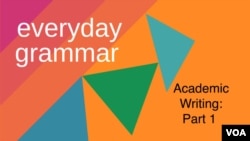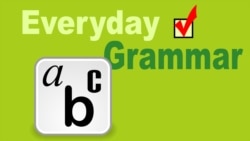The new school year is beginning in communities across the United States.
Many students are busy at work in their new classes. Some are already thinking about all the homework they will face in the weeks to come.
Schools often require students to read academic articles -- short or long reports about a class-related subject. Teachers also ask students to write book reports and research papers.
Today on Everyday Grammar, we will explore two grammatical structures that you will see often in academic writing.
We will show you how to use these structures. We also will show you when not to use them.
#1 Evaluating an idea
If you are writing or reading for academic purposes, you will likely see the following structure: It + is + an adjective + that-clause.
This is a common way to express an attitude, opinion or position. It is often used when considering an idea, note grammar experts Susan Conrad and Douglas Biber.
Here is an example:
"It is clear that the evidence is inconsistent."
Here is how you can understand the sentence. The subject in our example is the word it. Then comes the verb is. After is, there is an adjective: the word clear.
After clear, there is a that-clause. A that-clause is a group of words, beginning with the word that. It has a subject and a predicate. A predicate is the part of a sentence that expresses what is said about the subject.
The that-clause has the idea that the writer is considering. In the example we gave you, the idea under consideration is the following statement: "the evidence is inconsistent."
The adjective clear suggests the writer's judgment.
By saying "it is clear," the writer is saying that he or she agrees the evidence appears to be conflicting with other information.
Note that the writer did not write, "I think that the evidence is inconsistent," even if it has the same meaning as the example sentence. Why? We will explore that issue later in the report.
Academic writers often use it + is + an adjective + that-clause to raise questions, note possibility, and express importance.
For example, you might read the following sentence:
"It is unlikely that the results will be conclusive."
Or,
"It is likely that the information was incomplete."
In the former case, the writer is using the adjective unlikely to raise questions. In the latter one, the writer is using the adjective likely to express possibility.
#2 Evaluating an action
A second common structure, it + is + an adjective + an infinitive phrase, is often used to judge an action. The infinitive phrase describes the action. The adjective shows the writer's evaluation.
Consider this example:
"It is difficult to define these ideas."
In this example, the infinitive to define relates to an action, while the adjective difficult shows the writer's evaluation.
Writers often use it + is + an adjective + an infinitive phrase to show possibility, difficulty, importance, and so on.
So, for example, you might read the following sentences: "It is hard to understand these effects," or "It is necessary to carry out further research."
In the former example, the writer is expressing difficulty, while in the latter the writer is expressing necessity.
Other ways to express the same ideas
The two structures we have discussed are common in academic writing.
You should try using them with your own adjectives, that-clauses, infinitive phrases, and so on.
There is one point to keep in mind, however. You should know that sometimes you might not want to use these structures – especially if you are writing for business or even artistic reasons.
In those situations, it might be better to use more direct language.
Consider the first example we gave you, "It is clear that the evidence is inconsistent."
This is a common, acceptable way to write a sentence for academic purposes. It is grammatically correct.
However, the statement uses indirect language to express an evaluation. The writer is expressing an opinion without specifically writing "I think...," for example.
However, if you are writing for other purposes other than college professors, you could simplify your language. You could give a very direct evaluation by writing "I think the evidence is inconsistent," or simply "The evidence is inconsistent."
The structure that you choose to use depends on what kind of writing you are doing.
It is difficult to improve your writing. But with practice, you can do it!
I'm John Russell.
And I'm Pete Musto.
John Russell wrote this story for Learning English. George Grow was the editor.
We want to hear from you. Write to us in the Comments Section.
________________________________________________________
Words in This Story
that-clause – n. a part of a sentence (beginning with that) that has its own subject and verb
evaluate – v. to judge the value or condition of (someone or something) in a careful and thoughtful way
inconsistent – adj. having parts that disagree with each other
conclusive – adj. showing that something is certainly true
data – n. facts or information used usually to calculate, analyze, or plan something
infinitive phrase – n. an infinitive phrase is a group of words consisting of an infinitive, objects, and modifiers
concept – n. an idea of what something is or how it works
academic – adj. of or related to a school, especially of higher education
article – n. a piece of writing or story about a subject
verb – n. a word that expresses an action, event or state of being











